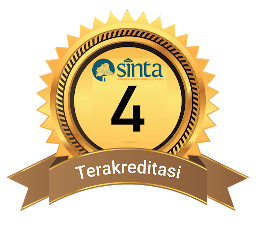Development of Practicum Module of Natural Chemical Science: Procedure of Making Trimyristin Soap From Nutmeg to Support Meaningful Learning
DOI:
10.29303/cep.v7i1.4714Published:
2024-05-31Issue:
Vol. 7 No. 1 (2024): Edisi Mei 2024Keywords:
Development, Practicum Module, Chemistry of Natural Materials, Trimyristin, SoapArticles
Downloads
How to Cite
Abstract
This research is a research and development with a 4D model research design (define, design, develop, and disseminate). This research aims to find out: (1) The process of developing a natural chemical science practicum module: procedure of making trimyristin soap from nutmeg to support meaningful learning. (2) The level of validity and practicality of the practicum module. The results showed that the validity value of the three validators obtained an average Aiken index value of V = 0.84 with an average reliability level of R = 0.93 which showed that practicum module was highly valid and feasible to use. Practicality can be seen from the responses of students and lecturers who showed positive responses with an average practicality of all aspects of 88% student responses and 89% of lecturer responses. The results of the physical evaluation of trimyristin solid soap (organoleptic, pH, foam stability, and moisture content) resulting from this study showed good results because they met several standards for the quality of solid soap SNI 3532-2016. In conclusion the developed of practicum module was highly valid and highly practical to be used in the learning process.
References
Arsyad, A. (2006). Media Pembelajaran. Jakarta: PT Raja Grafindo.
Asgarpanah, J., & Kazemiyas, N. (2012). Phytochemistry and pharmacologic properties of Myristica fragrans Hoyutt: A review. African Journal of Biotechnology. Islamic Azad University, Tehran. 11(65), 12787-12793.
Ausubel, D. P. (1962). A Subsumption Theory of Meaningful Verbal Learning and Retention. The Journal of General Psychology. 66(2), 213-224.
Badan Standarisasi Nasional Indonesia. (1994). Standar Mutu Sabun Mandi. SNI 06- 3532-1994. Jakarta: Dewan Standarisasi Nasional.
Baharuddin & Wahyuni, E. N. (2008). Teori Belajar dan Pembelajaran. Yogyakarta: Ar-Ruzz Media.
Bappenas. (2016). Indonesian Biodiversity Strategy and Action Plan. 2015-2020.
Damayanti, N. K. A., Maryam, S., & Subagia, I.W. (2019). Analisis Pelaksanaan Praktikum Kimia. Jurnal Pendidikan Kimia Undiksha, 3(2), 52. doi:10.23887/jjpk.v3i2.21141.
Daryanto. (2013). Menyusun Modul Bahan Ajar Untuk Persiapan Guru dan Mengajar. Yogyakarta: Gava Media.
Deragon, S.A., Daley, P.M., Maso, H.F., & Conrad, L.I. (1968). Studies on Lanolin Derivatives in Shampoo System. J. Soc Chemis.’s, 20, 777-793.
Febriani, A., Syafriana, V., Afriyando, H., & Djuhariah, Y. S. (2020). The utilization of oil palm leaves (Elaeis guineensis Jacq.) waste as an antibacterial solid bar soap. IOP Conference Series: Earth and Environmental Science. 572(1), 1–10.
Hadisoewignyo, L. & Fudholi, A. (2013). Sediaan Solida. Yogyakarta: Pustaka Pelajar.
Idoko, O., Emmanuel, S. A., Salau, A. A., & Obigwa, P. A. (2018). Quality assessment on some soaps sold in Nigeria. Nigerian Journal of Technology (NIJOTECH), 37(4), 1137–1140.
Josopandojo, B. & Purnomo, A. (2020). Studi Kemampuan Instalasi Pengelolaan Air Untuk Meminimalisasi Trihalometana (Studi Kasus IPA Siwalanpanji Kabupaten Sidoarjo). Jurnal Teknik ITS. 9(2), 2337-3539.
Mahmudah, S., Sukib, S., & Hakim, A. (2018). Pengembangan Modul Praktikum Kimia Bahan Alam: Isolasi Trimiristin dari Pala. Chemistry Education Practice, 1(1), 20- 25.
Ma’mun. (2013). Karakteristik Minyak dan Isolasi Trimiristin Biji Pala Papua (Myristica argentea). Jurnal Penelitian Tanaman Industri. 19(2), 72–77.
Maydiantoro, A. (2021). Model-Model Penelitian Pengembangan (Research and Development). FKIP Universitas Lampung.
Munawarah, Z., Burhanuddin, Sofia, B. F. D., dan Hakim, A. (2021). Pengembangan Multimedia Interaktif berbantuan Aplikasi Articulate Storyline dalam Pembelajaran Kimia Kelas XI MIPA SMAN 1 Utan. Jurnal Ilmiah Profesi Pendidikan. 6(4), 768-775.
Prasetiyo, A., Hutagaol, L., & Luziana, L. (2020). Formulasi Sabun Padat Transparan Dari Minyak Inti Sawit. Jurnal Jamu Indonesia. 5(2), 39-44.
Retnawati, H. (2016). Validitas Reliabilitas dan Karakteristik Butir (Panduan Untuk Peneliti, Mahasiswa, dan Psikometrian). Yogyakarta: Parama Publishing.
Standarisasi Nasional Indonesia. (2016). Standar Mutu Sabun Mandi. SNI 06- 3532-2016. Jakarta : Badan Standarisasi Nasional.
Sugiyono. (2017). Statistika untuk Penelitian. Bandung: Alfabeta Cv.
Thiagarajan, S., Semmel, D.S., & Semmel, M.I. (1974). Instructional Development for Training Teacher of Exceptional Children. Bloomington Indiana: Indiana University.
Torry, F. R. (2014). Pemanfaatan Trimiristin Sebagai Lemak Pala dalam Sabun Mandi. Majalah Biam. 10(1), 37-42.
Warnida, H., Wahyuni, D., & Sukawaty, Y. (2019). Formulasi dan Evaluasi Vanishing Cream Berbasis Lemak Tengkawang. Jurnal Penelitian Ekosistem Dipterokarpa. 5(1), 63-70.
Widyasanti, A., Rahayu, A. Y., & Zain, S. (2017). Pembuatan Sabun Cair Berbasis Virgin Coconut Oil (VCO) Dengan Penambahan Minyak Melati (Jasminum Sambac) Sebagai Essential Oil. Jurnal Teknotan. 11(2), 1-10.
Winarno. (1991). Kimia Pangan dan Gizi. Jakarta: Gramedia.
Zulbayu, La O. M. A., Juliansyah, R., & Firawati, (2020). Optimasi Konsentrasi Sukrosa Terhadap Transparansi dan Sifat Fisik Sabun Padat Transparan Minyak Atsiri Sereh Wangi (Cymbopogon citratus L.). Jurnal Mandala Pharmacon Indonesia. 6(2), 91-96.
Author Biography
Kukuh Waseso Jati Pangestu, Pendidikan Kimia/Pendidikan IPA/Universitas Mataram
License
Copyright (c) 2024 Kukuh Waseso Jati Pangestu, Aliefman Hakim, Lalu Rudyat Telly Savalas, Baiq Fara Dwirani Sofia

This work is licensed under a Creative Commons Attribution-ShareAlike 4.0 International License.
Authors who publish with Chemistry Education Practice agree to the following terms:
- Authors retain copyright and grant the journal right of first publication with the work simultaneously licensed under a Creative Commons Attribution License 4.0 International License (CC-BY-SA License). This license allows authors to use all articles, data sets, graphics, and appendices in data mining applications, search engines, web sites, blogs, and other platforms by providing an appropriate reference. The journal allows the author(s) to hold the copyright without restrictions and will retain publishing rights without restrictions.
- Authors are able to enter into separate, additional contractual arrangements for the non-exclusive distribution of the journal's published version of the work (e.g., post it to an institutional repository or publish it in a book), with an acknowledgement of its initial publication in Chemistry Education Practice.
- Authors are permitted and encouraged to post their work online (e.g., in institutional repositories or on their website) prior to and during the submission process, as it can lead to productive exchanges, as well as earlier and greater citation of published work (See The Effect of Open Access).






